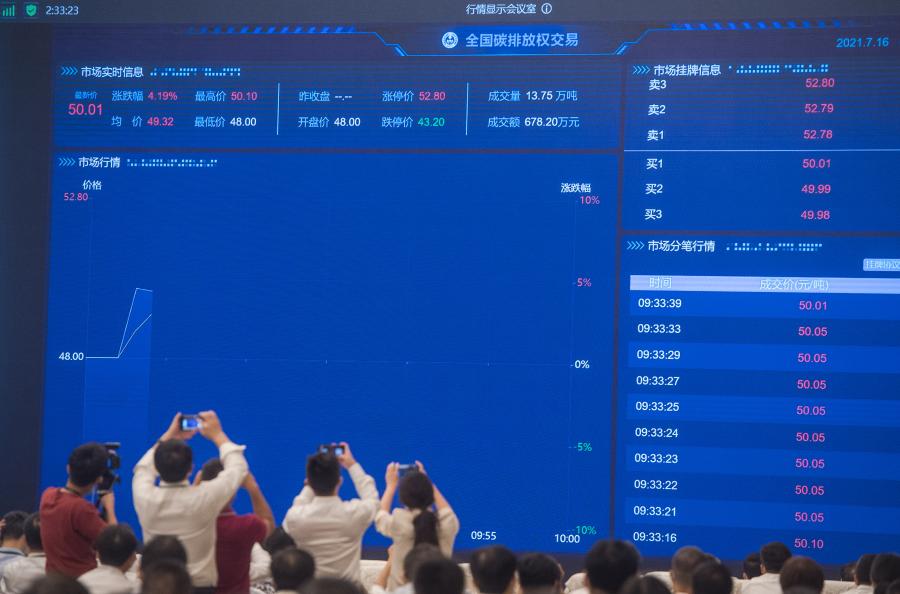
Wind turbines in Jiucaiping scenic spot in southwest China's Guizhou Province, August 19, 2020. /Xinhua
Editor's note: Qian Zhijun is an associate professor of China Institute of Finance and Capital Markets and specializes in China's economy and financial market. He served in Hong Kong as the senior economist at ICBC International Holdings Ltd. He holds a doctorate in economics from Renmin University of China, as well as a master's degree in public policy from the University of Chicago. The article reflects the author's opinions and not necessarily the views of CGTN.
Since July 16, 2021, China's national emission trading system (ETS) has launched for over one month. With five-week stable operation, the newborn national ETS has achieved significant breakthroughs in many aspects – the pricing efficiency of carbon emission allowances (CEA) is higher, and the market size expands step by step. More importantly, the national ETS is trying to explore a new path – institutional carbon emission reductions – as the ending of "campaign-style" emission reductions. Armed with continuous system and instrument innovation as well as the coordination of emission reductions and economic development, the new path of reductions may promote China to achieve carbon neutrality by 2060 in a "coordinated and orderly manner."
Breakthrough one: Optimize CEA pricing and boost market function
Compared with China's regional ETS pilots, the national ETS has improved the efficiency of CEA pricing.
First, it unifies carbon price signals, creating a reliable benchmark. China has established eight major ETS pilots in different regions since 2013. The carbon prices in these markets, however, vary greatly, even change in the opposite direction. For instance, the largest gap between the average carbon prices in these markets in 2020 was 34 yuan per ton, and the coefficient of price variation in the markets was up to 39.9 percent. Compared with the situation in 2019, the current prices in half pilot markets has increased, with a max growth rate of 96 percent, but the prices in other half witnessed a decline, with a maximum rate of 20 percent.
Different from the chaos in pilot markets, China's national ETS sends a clear price signal, which is conducive to regulate the supply and demand of CEA across China as a whole, and is good for providing price reference for more products of carbon exchange in the future too.
Moreover, the national ETS improves the accuracy of carbon allowance pricing and expedites the process of emission reductions. During the first five weeks of practice, the price in the national ETS is remarkably higher than the weighted average price in eight pilot markets, and the weekly average price premium is about 14.6 yuan per ton. This shows that because of market segmentation, the carbon prices in the pilot markets were systematically underestimated and failed to reflect the real supply-demand relationship of CEA in China. In comparison, the carbon price in the national ETS, which is more accurate and higher than its counterpart in regional markets, can better help force carbon-intensive enterprises to upgrade, and direct domestic capital into emission reduction technology research and low-carbon industries.

A screen displaying real-time information of China's national carbon emission trading system (ETS) in Wuhan, central China's Hubei Province. /Xinhua
Breakthrough two: Expand China's carbon market and accelerate green transformation
At present, China has established a two-tier system of "national market + regional pilot market" in its CEA trading market. The national ETS has been cultivating a considerable increment without the expense of pilot market stock in regions. For trading volume, the cumulative amount in the national ETS has reached 7.9 million tons. Looking forward, assuming that the trading volume in the national ETS maintains the current trend, its annual trading amount is likely to exceed 70 million tons.
For the perspective of emission reduction efficiency, China's carbon market has included 2,162 power plants, which cover about 4.5 billion tons of carbon dioxide emissions, and has been the largest market in the world. This market size holds around 45 percent of carbon emissions in China, similar to current coverage of the European counterpart.
In the future, China's power industry may reduce its carbon emissions by 15 percent every year according to European experience. This means that China's carbon market is expected to decrease the national emission by 6.8 percent each year, much higher than the global rate of 1.9 percent. Thus it will become an important contributor of green transformation for both China and the world.
Breakthrough three: Improve carbon reduction mechanism and explore the effective way of carbon neutrality
The Meeting of the Political Bureau of the Central Committee of the Communist Party of China held on July 30 has stressed that it needs to plan the course of carbon peaking and carbon neutrality as a whole and to correct the "campaign-style" emission reductions. Against this background, the stable operation of the country's national ETS just demonstrates that the Chinese people have the wisdom and ability to explore a new way of institutional emission reductions, and to realize the goal of carbon neutrality step by step.
Some lessons can be learned from the national ETS. On the one hand, the establishment and improvement of such a unified national emission reduction mechanism can not only curb the impulse of local governments of all levels adding requirements, but also block the space for market players crossing regions to arbitrage. What's more, this meets the Politburo meeting's requirement of "ensuring a coordinated national response" and "establishing then breaking." On the other hand, the carbon price shaped by the national ETS is high enough to stimulate enterprises to reduce emissions, and is significantly lower than the European and American prices, which is in line with the principle of "common but differentiated responsibilities" as well as coordinates carbon emissions and economic development.
More institutional innovations are likely to take place in the future. As for the carbon market itself, the allocation efficiency will possibly become higher by establishing a stabilization mechanism for carbon price, transforming carbon quotas from free distribution to auction gradually, and expanding the market participants in an orderly manner.
 简体中文
简体中文

